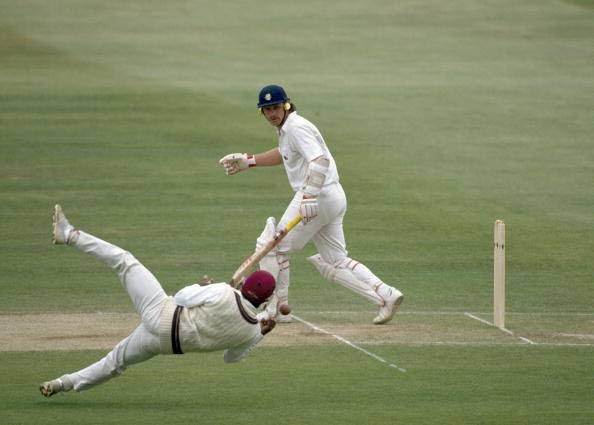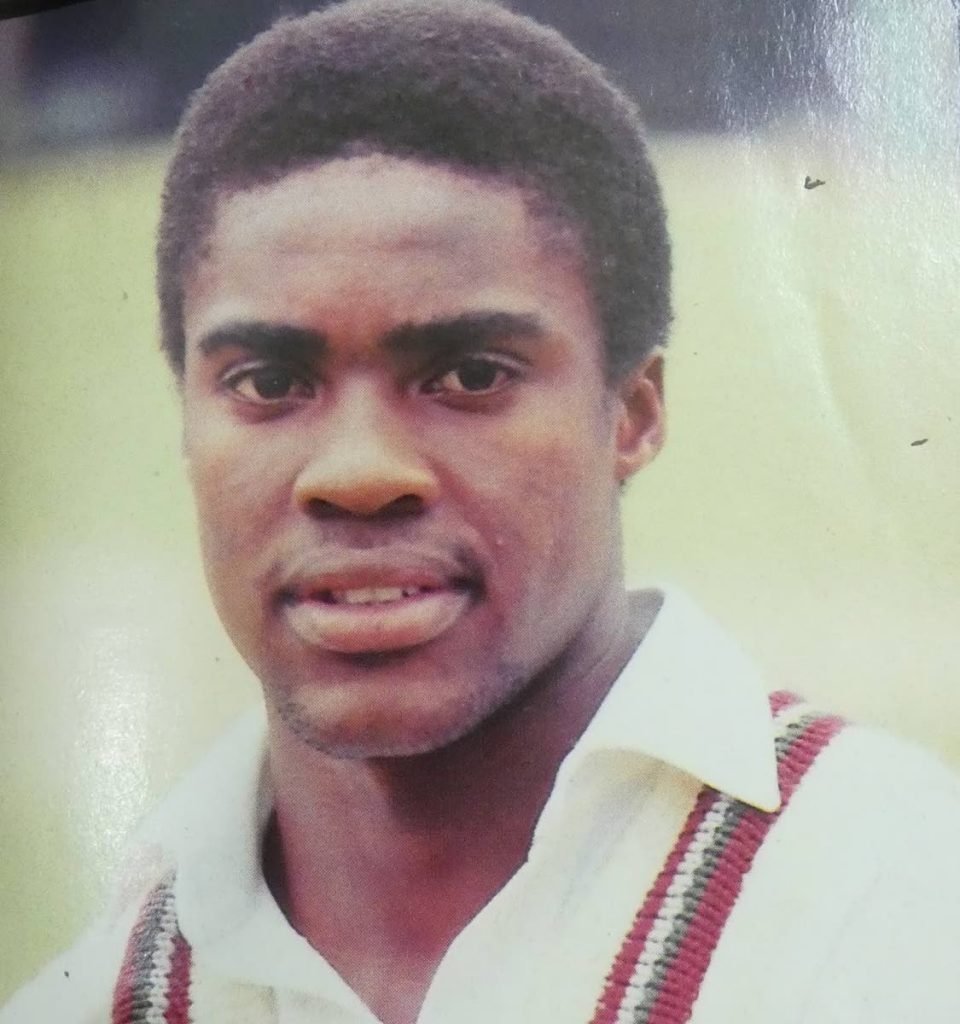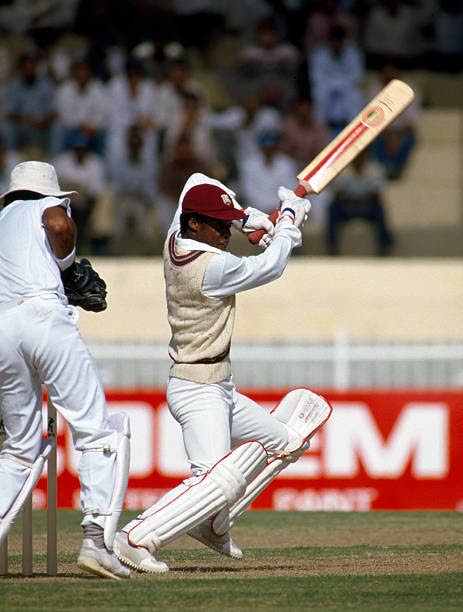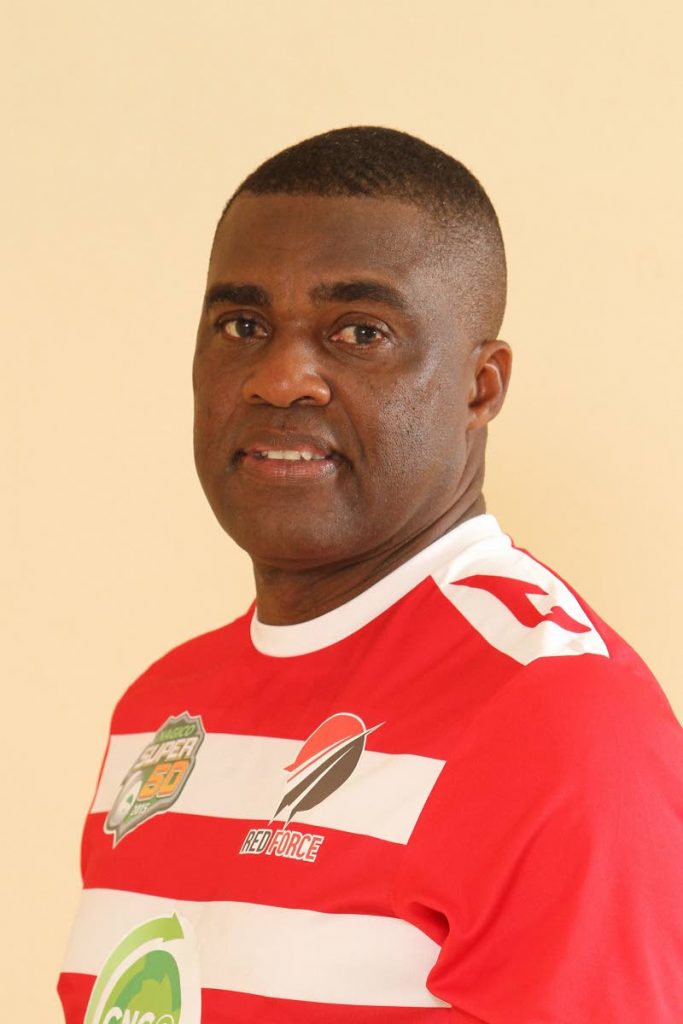Small in size, big at heart

THE POCKET-SIZED Gus Logie was born September 28, 1960.
Those were the glorious days of the West Indies — the 1980s; there were dominating, all-conquering batsmen that dominated all attacks; there were battalions of ruthless, relentless fast bowlers who simply kept coming at you; and behind the stumps, there were the eager gloves of Jeff Dujon to pull off any catch, however impossible.
To support them there were the fielders: there were the safe Clive Lloyd and Gordon Greenidge who manned the slips, the deceptively athletic Viv Richards, a great outfielder who was also brilliant in the slips, that giant Joel Garner who used his absurd reach to prowl around in fourth slip or gully; and there was the livewire Roger Harper who could pull off miracles on the field.
And then, there was Augustine Lawrence Logie.
In a country that has acquired a reputation of producing flamboyant larger-than-life giants over decades Gus Logie was a complete mismatch; he was diminutive, he could not tear a bowling to shreds the way some of his teammates could, and neither could he pile up humongous piles of runs.
He was an attractive strokeplayer, though, and went on song he was a treat to watch; once he got his eye in he had the ability to take on most attacks in the world. He was not an aggressive dominator, but when the need arose the pint-sized man often rose to the occasion.

His small frame and the fact that he had spent his early days on bouncy tracks meant that Logie was a good cutter and puller of the ball. However, when anything was pitched off, he used his exemplary footwork — especially against the spinners — to unleash his powerful drives and wristy flicks as well.
His main claim to fame, however, was his fielding; in ODIs he lurked around in point or cover like a panther, ready to pounce upon every chance; he took unbelievable catches, and long before Jonty Rhodes he had the ability to hit the stumps from impossible angles on a consistent basis.
In Tests, he fielded closer to the bat, and was a menace in close quarters with his snakelike agility and unbelievable reflex. Batsmen seldom dared to play the flick or pull when he was placed at forward short-leg. They had a reason to.
Had he not been a fielder of that pedigree, Logie may not have had a career as long as he did. He scored 2,470 runs at 35.79 from 52 Tests with two hundreds and held 57 catches; he also scored 2,809 runs from 158 One-Day Internationals at an average of 28.95 (his career was bloated by the fact that 27 per cent of his innings were not outs) and a strike-rate of 73.90, and had 61 catches. Even in First-Class cricket Logie’s numbers read 7,682 runs at 35.07 with 13 hundreds, 106 catches, and a stumping.
What these numbers do not take into account is the number of runs he had saved during his career and the psychological pressure his sheer presence on the cricket ground created. Details of ground fielding, unfortunately, remain among the least documented sections of the sport.

EARLY DAYS
Logie was born in Sobo, Trinidad, and after going through the age divisions and a decent career for the Texaco-Brighton Club he made his First-Class debut for South Trinidad against North Trinidad. The 17-year-old registered a pair on debut but impressed everyone with his fielding. The first hundred came next season for South and Central Trinidad against North and Eastern Trinidad where he scored 121.
Breaking through to the West Indian side, however, was out of the question. Richards and Greenidge had filled the big shoes of Garry Sobers and Rohan Kanhai, Lloyd was still going strong, Alvin Kallicharran was still around and Desmond Haynes and Larry Gomes had appeared on the scene.
ODI DEBUT
Despite the challenges, Logie kept on scoring runs and managed to grab the attention of the selectors. He got an unexpected call-up for the Australia tour of 1981-82. He did not play a single Test but was picked for four ODIs; sadly, West Indies won the matches so easily (they lost only 13 wickets) that Logie did not get a chance to bat in any of them.
Back home, he slammed 171 against Jamaica; it would remain his First-Class best. After a run of 138 and 79 against Windward Islands, 46 and 43 not out against Leeward Islands, and 117 and 62 against Guyana in back-to-back matches next season he was selected for the first Test against India at Sabina Park.
TEST DEBUT
It was not the most auspicious of starts. Logie was run out in the first innings for 13 in the first innings, but hit a crucial six before being trapped leg-before to Kapil Dev when West Indies chased down 173 in 25.2 overs. Logie hit the first ball of the innings he faced (off Mohinder Amarnath) for six, being only the 10th batsman to do so.
He got 10 more in the next Test at Queen’s Park Oval and was caught behind off Balvinder Sandhu for a duck at Bourda. Even after 36 runs in four innings the selectors decide to persist with Logie, and he was picked for the fourth Test at Kensington Oval.
West Indies were 230/3 after Andy Roberts bowled out India for 209 when Logie walked out to bat. He got a chance on seven when Srinivas Venkataraghavan dropped him off Ravi Shastri at first slip, and did not look back. Logie remained unbeaten on 72 at stumps on Day Three and reached his maiden Test hundred the next morning. He eventually fell for 130 before being caught by Amarnath off Shastri. West Indies won the series the next day when they needed one to win and Syed Kirmani settled things by bowling a no-ball.

The next Test at St John’s ended in yet another draw on a flat track; while Greenidge, Haynes, Lloyd, and Dujon all piled up hundreds for West Indies, Logie scored a solitary run before being hit-wicket off Kapil. Despite the hundred (which remained the highest score of his career) Logie managed only 167 runs at 27.83 from the series.
He batted for the first time in an ODI against India at Queen’s Park Oval, scoring six not out; he got to play a single match in the World Cup, against Zimbabwe at Edgbaston, where Haynes and Faoud Bacchus led West Indies to a 10-wicket victory. He fielded as a substitute in the final, and got his name on the scorecard when he caught Yashpal Sharma off Gomes at deep third-man.
On the India tour he scored a duck at Kanpur, a 63 at Delhi, and a pair at Ahmedabad. At this stage Logie had crossed 13 only twice in his first 10 innings and his career prospects did not look to good, especially after Richie Richardson’s arrival on the scenario.
THE GRADUAL RISE
Logie was recalled for the second Test of the home series against Australia at Queen’s Park Oval when Lloyd opted out with a pulled hamstring. After Joel Garner bowled out Australia for 255 the tourists struck back, reducing West Indies to 129/4. Logie walked out to add 100 with Richards and 158 with Dujon to tilt the Test in West Indies’ favour. He himself scored a 191-ball 97 with 10 fours. It took a heroic effort from Allan Border to save the Test.
Lloyd returned the Test and it was almost certain that given Logie’s form the axe would fall on Richardson. However, Logie went down with influenza at the last moment and missed the Test; Richardson retained his spot, scored a dazzling 131 in the next Test at Kensington Oval, and West Indies won by 10 wickets.
Poor Logie was forgotten. His exceptional fielding meant that he played the Benson & Hedges World Series Cup matches later that year in Australia. He pulled off a victory when West Indies were 89/4 chasing 166 at Adelaide when he scored 49 not out, dominated a partnership with Lloyd, and picked up his first Man of the Match award.
West Indies won the first final at SCG and the second one at MCG was tied. In the third final, also at MCG, a depleted West Indies had to go in with six bowlers. It was “partly as an indication of their dissatisfaction at having to play at all”, wrote Wisden. They were not happy about the tie in the previous match.
Garner restricted Australia to 212/8 before Geoff Lawson reduced the tourists to 3/2. Logie walked out, lost Richardson early, but carved out a match-winning 103-ball 88, adding 124 with Dujon, who was pushed up to No. 5. West Indies won the tournament.
By now Logie had been branded as an ODI specialist, playing Tests only sporadically. In a phase lasting for close to four years he was selected for only seven Tests — all of them over two series, both against New Zealand. He managed to score a single fifty in the 10 innings he batted.
He had toured England in 1984 and scored 141 against Leicestershire and 122 not out against Nottinghamshire. He finished the tour with 585 runs at 73.12 but did not find a place in the rampant West Indies side that inflicted a whitewash.
It was not that he was scoring runs consistently in ODIs either. There was a gap created after Lloyd’s retirement, but Carl Hooper had followed Richardson into the Test side, which meant that even Gomes wasn’t missed for long. However, he managed to play more than he did not – mostly because of his fielding than anything else.
The best example of his ability in the field came in the Champions Trophy match against Pakistan at Sharjah in 1986. He began by catching Saleem Yousuf off Tony Gray, and ended Mudassar Nazar’s misery by catching him off Winston Benjamin. Then, as Rameez Raja and Javed Miandad looked like getting away with the proceedings he ran out Miandad with a direct hit.
Alongside all this he fielded brilliantly, saving runs to choke the Pakistan innings. He also caught Ijaz Ahmed off Harper, and ran out Asif Mujtaba. Pakistan collapsed for 143; Logie had effected five dismissals. He did not get a bat as West Indies romped to a nine-wicket victory, but he still managed to win the Man of the Match award for his fielding, the first person to achieve this feat.
FINDING HIS GROOVE
It was against India that Logie had had an ordinary run in 1983. Now, it was against the same opponents that he eventually had a turnaround. Chasing 276 (a record on Indian soil), West Indies were reduced to 111/4, but Logie stuck around, scoring 46 against the turning ball; he added 92 with Richards, who eventually finished the match.
On a featherbed in the third Test at Calcutta, Logie scored his second Test hundred after almost five years since his first; the 101 came off 136 balls with 15 fours. With Greenidge and Dujon also scoring hundreds West Indies amassed 530/5, but India managed a lead and the Test was drawn.
His finest innings of the series came at Madras, where Narendra Hirwani set a new world record by picking up 16 for 136 on debut. West Indies were all at sea against the leg-spinner, especially while chasing 416 in the fourth innings. Logie used his feet better than anyone in the side and scored a 62-ball 67 with eight fours and two sixes. West Indies, however, lost by plenty.
In the famous home series against Pakistan he top-scored with a counterattacking 96-ball 80 against Imran Khan, Wasim Akram, and Abdul Qadir in the first innings at Bourda, but did little else of notice. However, he also scored an outstanding 109 not out in 119 balls — his only ODI hundred — at Sabina Park, coming out to bat at 25/2. The two innings won him a berth on the England tour.
LOGIE’S FINEST HOUR
Logie did not have an auspicious start to the tour and failed in the first Test at Trent Bridge, scoring 20 in the only innings he batted. He failed in the subsequent tour matches that followed but was still retained for the second Test at Lord’s.
The Lord’s Test was probably the highest point of Logie’s Test career. For a change England got back at the tourists with Graham Dilley reducing them to 54/5. Logie was dropped by Derek Pringle at first slip off Dilley when he was on 10, but thereafter he steadied the ship with Dujon.
Thus reprieved, Logie tore into the English attack. He hit 12 boundaries in his fifty, being only the fourth cricketer to do so. Wisden wrote that he “took the attack excitingly to the bowlers”. However, he became more cautious after he reached his fifty and added a crucial 130 with Dujon.
Just when it seemed that there was another century on the cards, Logie was caught at point by the English captain John Emburey off Gladstone Small. He had scored 81 in 189 balls with 14 fours and West Indies had reached 209. Malcolm Marshall responded by providing his side with a 44-run lead.
The second innings was relatively easier. West Indies went in pursuit of quick runs and Logie walked out at a comfortable 226/4. The wickets fell in a heap to Dilley and Paul Jarvis as the tail-enders tried to go for a slog and West Indies were bowled out for 397 after being 371/5. Logie was left stranded with a 124-ball 95 with 12 boundaries. England lost by 134 runs.
Logie did not cross fifty in the series again, but ended up scoring 39, 44, 47, and 38 not out in his remaining four innings. He scored 364 runs at 72.80 and topped the West Indian charts in both runs and averages by a significant margin. His performance throughout the year won him the Trinidad and Tobago Sportsman of the Year Award.
HANGING ON
The 1988 Wisden Trophy helped Logie kept his place in the Test side for a few years. With the career of both Richards and Greenidge reaching their end, Logie became a crucial cog in the team. There were the occasional flashes of brilliance: top-scoring with 87 against India at Queen’s Park Oval in 1989 was the first of these.
More significantly, Logie scored a 139-ball 98 with 11 fours to help West Indies reach 199; the innings included a ninth-wicket stand of 74 in 101 balls with Ian Bishop: Logie’s Trinidad teammate managed only 16.
THE SABINA PARK CLASSIC
He played out of his skin again in the Sabina Park Test against Australia in 1991. Craig McDermott and Merv Hughes bowled with hostile pace; Haynes was retired hurt, and West Indies lost four other batsmen with 57 on the board. Soon after Logie walked out he received a brute of a delivery from McDermott that hit him on his face, forcing him to retire.
Logie was on nine when he had to walk off. When he eventually resumed with seven stitches above his right eye, West Indies had even lost Courtney Walsh. With Dujon at the other end Logie decided to go for it. He lost Dujon after a 68-run partnership but it did not matter. He went on hitting until Patterson was clean bowled by Hughes.
Wisden wrote: “Seemingly unperturbed by his injury, Logie moved from nine to 77 with dazzling strokeplay, his innings, from just 110 balls, containing twelve fours.” The runs were scored out of 98 during his stay at the wicket.
FINAL DAYS
Barring that single innings Logie generally had a disappointing series. He was picked for the Wisden Trophy mostly based on his performance in the previous series. He disappointed, scoring 120 runs at 24; the tally included a clean-hitting 78 at Trent Bridge.
It remained Logie’s last series. Though it was not a great Test career, Logie could take some pride in playing in 14 Test series and not losing a single one.
He played his third World Cup but did not do anything of note other than his explosive innings at Christchurch. After South Africa were reduced to 200/8, Meyrick Pringle hit back, eventually picking up 4/11. Logie, coming out to bat at 19/4, was the only man to put up some resistance; he scored 61 in 69 balls as West Indies were bowled out for 136.
It remained his last ODI fifty. He toured Australia later that year but did not get to play a Test. He also played eight Benson & Hedges matches, scoring 92 runs at 13.14. It was evident that his days were numbered. He retired from First-Class cricket after scoring 99 in a tour match against New South Wales after West Indies had followed on.
He continued to play till the 1992-93 home series against Pakistan where he scored 18 runs at 4.50. He quit from List A Cricket subsequently. That year he won the Humming Bird Silver Medal for his service to sport in Trinidad and Tobago.
He continued to play for Texaco-Brighton, his third-division club-side, for some time on the grounds that the club had picked him when he was an unknown face in the world of cricket and it would be only fitting if he had finished his playing days there before he made his shift to coaching.
POST-RETIREMENT
Logie shifted to Australia to take up coaching, and won the NCA coaching award in 1994 and the NCA Senior Coaching Award in 1995. He also did a Level III Coaching Course under ECB in 2000, and was a part of the World Cricket Coaches’ Conference in 1999 and 2001.
Logie’s coaching career had started as early in 1987 when he had coached schools in Central Lancashire. He coached Windward Islands from 1997 to 1999, and then the West Indies Under-15 team in the World Cup of 2000 and the Under-19 team to numerous tours between 1998 and 2002. He also coached West Indies B and A sides.
He went on to coach Canada in the 2003 World Cup where the side exceeded all expectations and shocked quite a few teams. Later that year, he was appointed for the coach of the West Indies. After a not-too-peaceful tenure he quit in 2004.
The next year Logie joined Bermuda as the coach; the country made their first World Cup appearance two years later. He held on to the post till 2009 when he quit when Bermuda failed to qualify for the 2011 World Cup. He has gone back to Canada after a three-year hiatus.
Editor's Note: Logie, who also worked with the Trinidad and Tobago and Jamaica cricket teams, is currently the coach of the West Indies women's cricket team.
(cricketcountry.com)


Comments
"Small in size, big at heart"